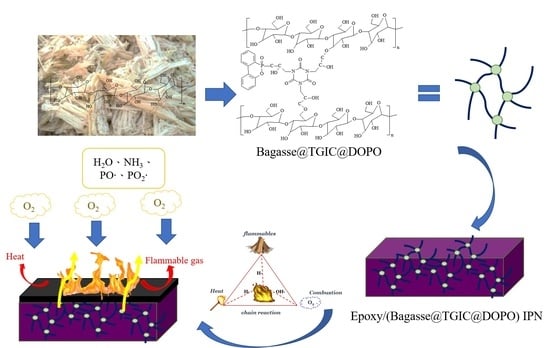Thermal Stability, Smoke Density, and Flame Retardance of Ecotype Bio-Based Flame Retardant Agricultural Waste Bagasse/Epoxy Composites
Abstract
1. Introduction
2. Materials and Methods
2.1. Materials
2.2. Preparation of Epoxy/Bagasse@TGIC@DOPO IPN
2.3. Measurements
3. Results and Discussion
3.1. Thermal Properties
3.2. Kinetics of Thermal Degradation
3.3. Smoke Density Test
- V is the smoke box volume (m3);
- A is the sample exposure area (m2);
- L is the optical path length (m);
- T is the transmittance rate (%).
3.4. Flame Retardance
3.5. Morphology
3.6. Char Analysis
4. Conclusions
Author Contributions
Funding
Institutional Review Board Statement
Informed Consent Statement
Data Availability Statement
Conflicts of Interest
References
- Luo, Q.; Sun, Y.; Yu, B.; Li, C.; Song, J.; Tan, D.; Zhao, J. Synthesis of a novel reactive type flame retardant composed of phenophosphazine ring and maleimide for epoxy resin. Polym. Degrad. Stab. 2019, 165, 137–144. [Google Scholar] [CrossRef]
- Umar, K.; Yaqoob, A.A.; Ibrahim, M.N.M.; Parveen, T.; Safian, M.T. Chapter Thirteen-Environmental Applications of Smart Polymer Composites. In Smart Polymer Nanocomposites: Biomedical and Environmental Applications; Woodhead Publishing Series in Composites Science and Engineering; Elsevier Inc.: Cambridge, MA, USA, 2021; pp. 295–312. [Google Scholar]
- Chen, R.; Hu, K.; Tang, H.; Wang, J.; Zhu, F.; Zhou, H. A novel flame retardant derived from DOPO and piperazine and its application in epoxy resin: Flame retardance, thermal stability and pyrolysis behavior. Polym. Degrad. Stab. 2019, 166, 334–343. [Google Scholar] [CrossRef]
- Chen, X.; Ma, C.; Jiao, C. Enhancement of flame-retardant performance of thermoplastic polyurethane with the incorporation of aluminum hypophosphite and iron-graphene. Polym. Degrad. Stab. 2016, 129, 275–285. [Google Scholar] [CrossRef]
- Mark, J.; Guardia, L.; Hale, R.C. Halogenated flame-retardant concentrations in settled dust, respirable and inhalable particulates and polyurethane foam at gymnastic training facilities and residences. Environ. Int. 2015, 79, 106–114. [Google Scholar]
- Jiang, D.; Pan, M.; Cai, X.; Zhao, Y. Flame retardancy of rice straw-polyethylene composites affected by in situ polymerization of ammonium polyphosphate/silica. Compos. Part A Appl. Sci. Manuf. 2018, 109, 1–9. [Google Scholar] [CrossRef]
- Kavitha, D.; Murugavel, S.C.; Thenmozhi, S. Flame retarding cardanol based novolac-epoxy/rice husk composites. Mater. Chem. Phys. 2021, 263, 124225. [Google Scholar] [CrossRef]
- Guna, V.; Ilangovan, M.; Rather, M.H.; Giridharan, B.V.; Prajwal, B.; Krishna, K.V.; Venkatesh, K.; Reddy, N. Groundnut shell/rice husk agro-waste reinforced polypropylene hybrid biocomposites. J. Build. Eng. 2020, 27, 100991. [Google Scholar] [CrossRef]
- Safian, M.T.; Umar, K.; Parveen, T.; Yaqoob, A.A.; Ibrahim, M.N.M. Chapter Eight-Biomedical applications of smart polymer composites. In Smart Polymer Nanocomposites: Biomedical and Environmental Applications; Woodhead Publishing Series in Composites Science and Engineering; Elsevier Inc.: Cambridge, MA, USA, 2021; pp. 183–204. [Google Scholar]
- Guna, V.; Ilangovan, M.; Hu, C.; Venkatesh, K.; Reddy, N. Valorization of sugarcane bagasse by developing completely biodegradable composites for industrial applications. Ind. Crop. Prod. 2019, 131, 25–31. [Google Scholar] [CrossRef]
- Peng, X.; Liu, Q.; Wang, D.; Liu, C.; Zhao, Y.; Wang, R.; Zheng, P. A hyperbranched structure formed by in-situ crosslinking of additive flame retardant endows epoxy resins with great flame retardancy improvement. Compos. B 2021, 224, 109162. [Google Scholar] [CrossRef]
- Xiong, X.; Zhou, L.; Ren, R.; Liu, S.; Chen, P. The thermal decomposition behavior and kinetics of epoxy resins cured with a novel phthalide-containing aromatic diamine. Polym. Test. 2018, 68, 46–52. [Google Scholar] [CrossRef]
- Zhang, X.H.; Chen, S.; Min, Y.Q.; Qi, G.R. Synthesis of novel bisphenol containing phthalazinone and azomethine moieties and thermal properties of cured diamine/bisphenol/DGEBA polymers. Polymer 2006, 47, 1785–1795. [Google Scholar] [CrossRef]
- Hidalgo, J.; Fernández-Blázquez, J.P.; Jiménez-Morales, A.; Barriere, T.; Gelin, J.C.; Torralba, J.M. Effect of the particle size and solids volume fraction on the thermal degradation behaviour of Invar 36 feedstocks. Polym. Degrad. Stab. 2013, 98, 2546–2555. [Google Scholar] [CrossRef][Green Version]
- Ozawa, T. A New Method of Analyzing Thermogravimetric Data. Bull. Chem. Soc. Jpn. 1965, 38, 1881–1886. [Google Scholar] [CrossRef]
- Corneliu, H.; Tachita, V.B.; Oana, P.; Gabriela, L. Kinetics of thermal degradation in non-isothermal conditions of some phosphorus-containing polyesters and polyesterimides. Eur. Polym. J. 2007, 43, 980–988. [Google Scholar]
- Quan, C.; Gao, N.; Song, Q. Pyrolysis of biomass components in a TGA and a fixed-bed reactor: Thermochemical behaviors, kinetics, and product characterization. J. Anal. Appl. Pyrolysis 2016, 121, 84–92. [Google Scholar] [CrossRef]
- Xu, W.; Wang, X.; Wu, Y.; Li, W.; Chen, C. Functionalized graphene with Co-ZIF adsorbed borate ions as an effective flame retardant and smoke suppression agent for epoxy resin. J. Hazard. Mater. 2019, 363, 138–151. [Google Scholar] [CrossRef] [PubMed]
- Wang, B.; Sheng, H.; Shi, Y.; Song, L.; Zhang, Y.; Hu, Y.; Hu, W. The influence of zinc hydroxystannate on reducing toxic gases (CO, NOx and HCN) generation and fire hazards of thermoplastic polyurethane composites. J. Hazard. Mater. 2016, 314, 260–269. [Google Scholar] [CrossRef] [PubMed]
- Chiu, H.T.; Chiu, S.H.; Jeng, R.E.; Chung, J.S. A study of the combustion and fire-retardance behaviour of unsaturated polyester/phenolic resin blends. Polym. Degrad. Stab. 2000, 70, 505–514. [Google Scholar] [CrossRef]
- Li, Q.; Wang, J.; Chen, L.; Shi, H.; Hao, J. Ammonium polyphosphate modified with b-cyclodextrin crosslinking rigid polyurethane foam: Enhancing thermal stability and suppressing flame spread. Polym. Degrad. Stab. 2019, 161, 166–174. [Google Scholar] [CrossRef]
- Wang, P.; Yang, F.; Li, L.; Cai, Z. Flame retardancy and mechanical properties of epoxy thermosets modified with a novel DOPO-based oligomer. Polym. Degrad. Stab. 2016, 129, 156–167. [Google Scholar] [CrossRef]
- Yang, R.; Hu, W.; Xu, L.; Song, Y.; Li, J. Synthesis, mechanical properties and fire behaviors of rigid polyurethane foam with a reactive flame retardant containing phosphazene and phosphate. Polym. Degrad. Stab. 2015, 122, 102–109. [Google Scholar] [CrossRef]
- Velencoso, M.M.; Ramos, J.M.; Klein, R.; Lucas, A.D.; Rodriguez, F.J. Thermal degradation and fire behaviour of novel polyurethanes based on phosphate polyols. Polym. Degrad. Stab. 2014, 101, 40–51. [Google Scholar] [CrossRef]
- Pal, K.; Kang, D.J.; Kim, J.K. Microstructural investigations of zirconium oxide—on core–shell structure of carbon nanotubes. J. Nanopart. Res. 2011, 13, 2597–2607. [Google Scholar] [CrossRef]
- Qian, Y.; Wei, P.; Jiang, P.; Zhao, X.; Yu, H. Synthesis of a novel hybrid synergistic flame retardant and its application in PP/IFR. Polym. Degrad. Stab. 2011, 96, 1134–1140. [Google Scholar] [CrossRef]
- Shi, Y.; Wang, G. The novel silicon-containing epoxy/PEPA phosphate flame retardantfor transparent intumescent fire resistant coating. Appl. Surf. Sci. 2016, 385, 453–463. [Google Scholar] [CrossRef]
- Wu, C.S.; Liu, Y.L.; Chiu, Y.S. Epoxy resins possessing flame retardant elements from silicon incorporated epoxy compounds cured with phosphorus or nitrogen containing curing agents. Polymer 2002, 43, 4277–4284. [Google Scholar] [CrossRef]
- Xu, M.J.; Xu, G.R.; Leng, Y.; Li, B. Synthesis of a novel flame retardant based on cyclotriphosphazene and DOPO groups and its application in epoxy resins. Polym. Degrad. Stab. 2016, 123, 105–114. [Google Scholar] [CrossRef]
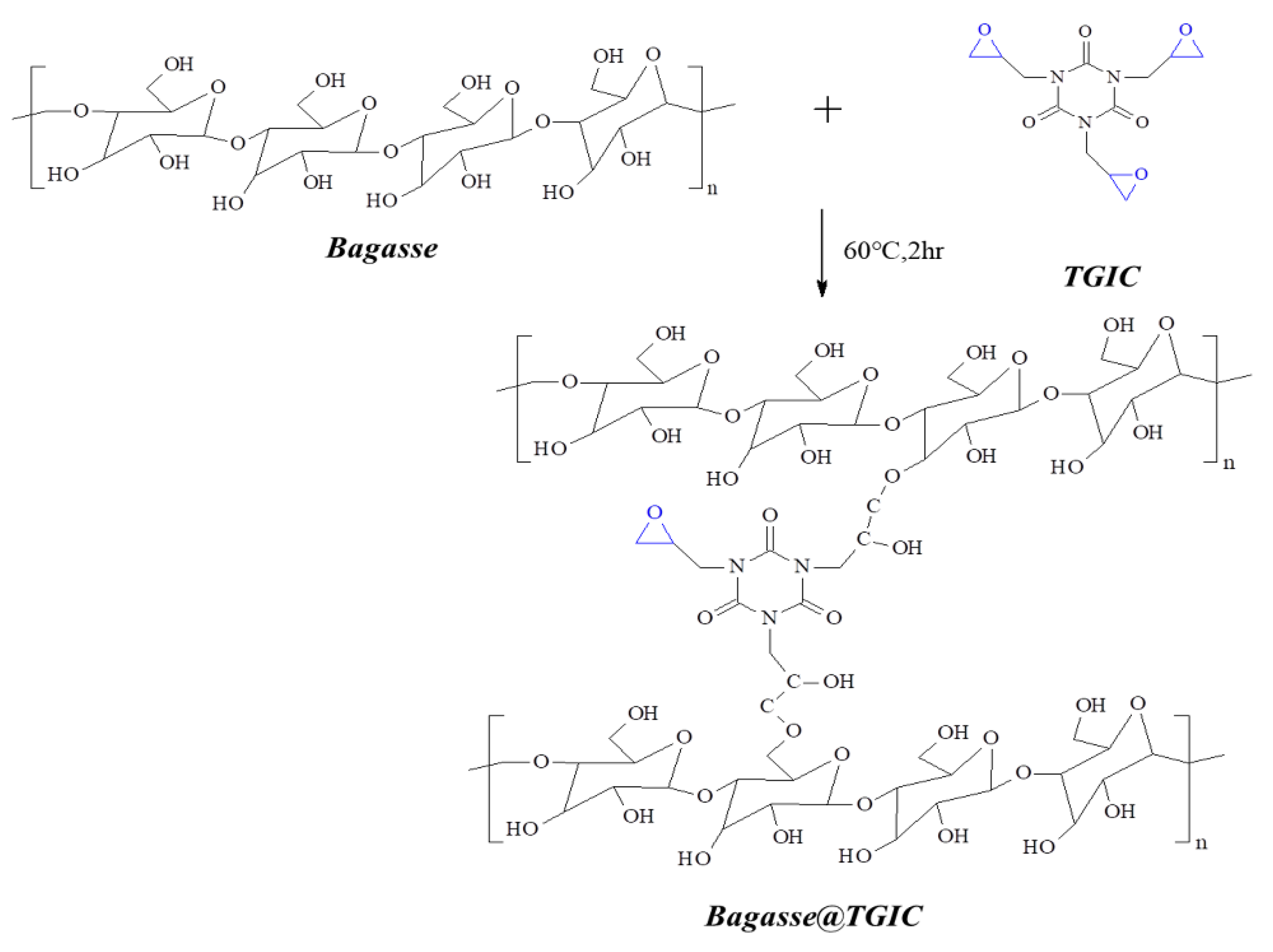
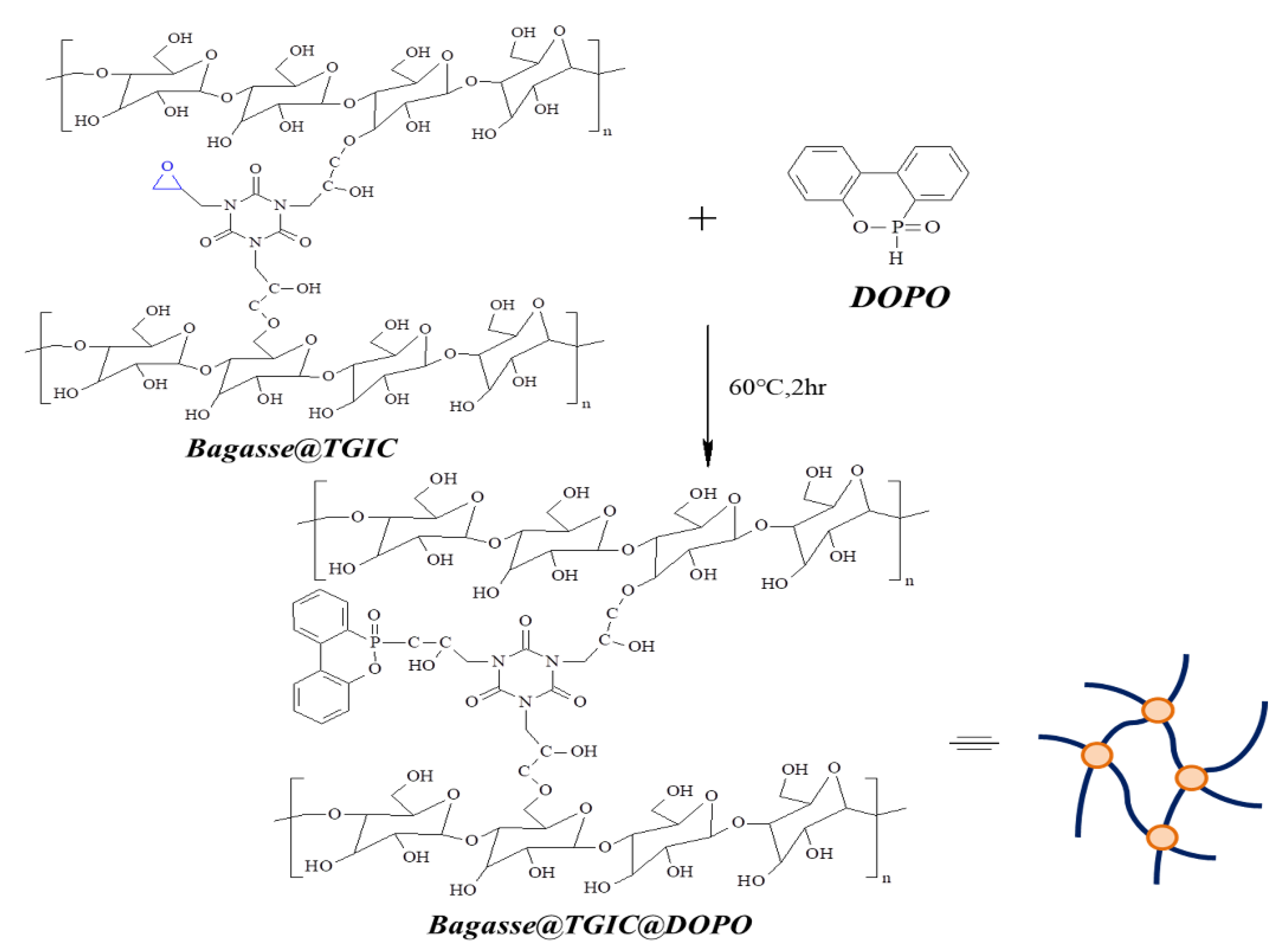
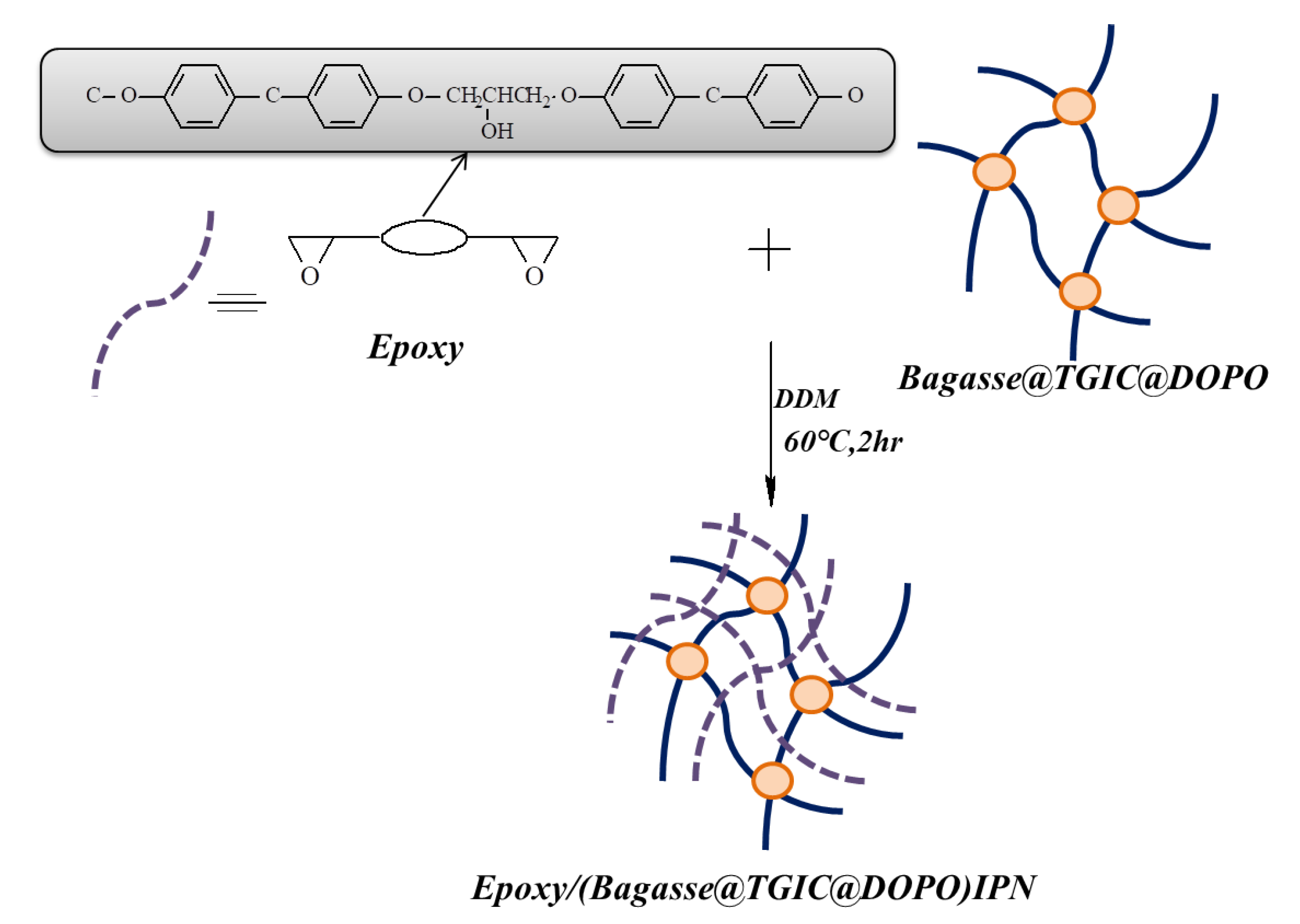

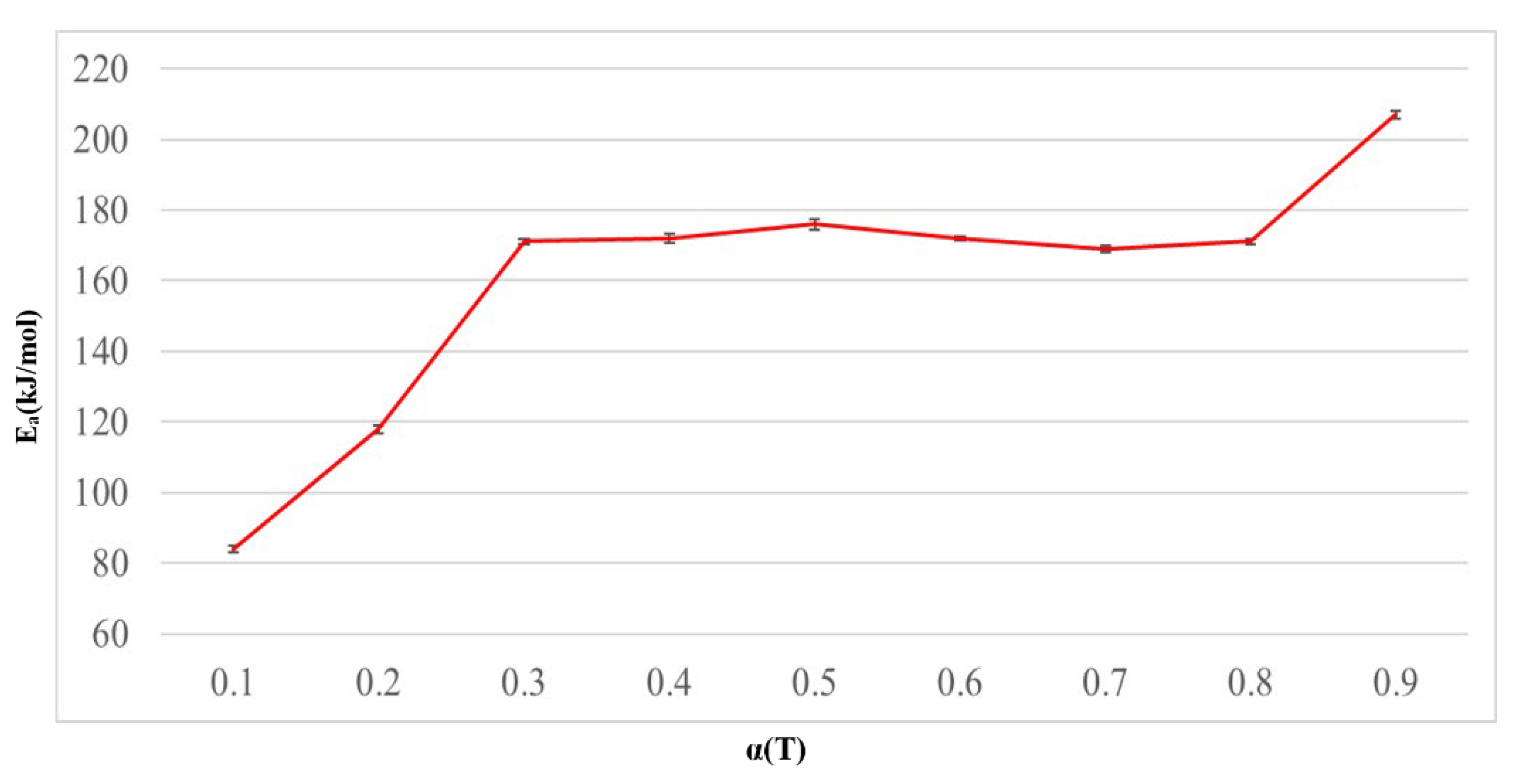
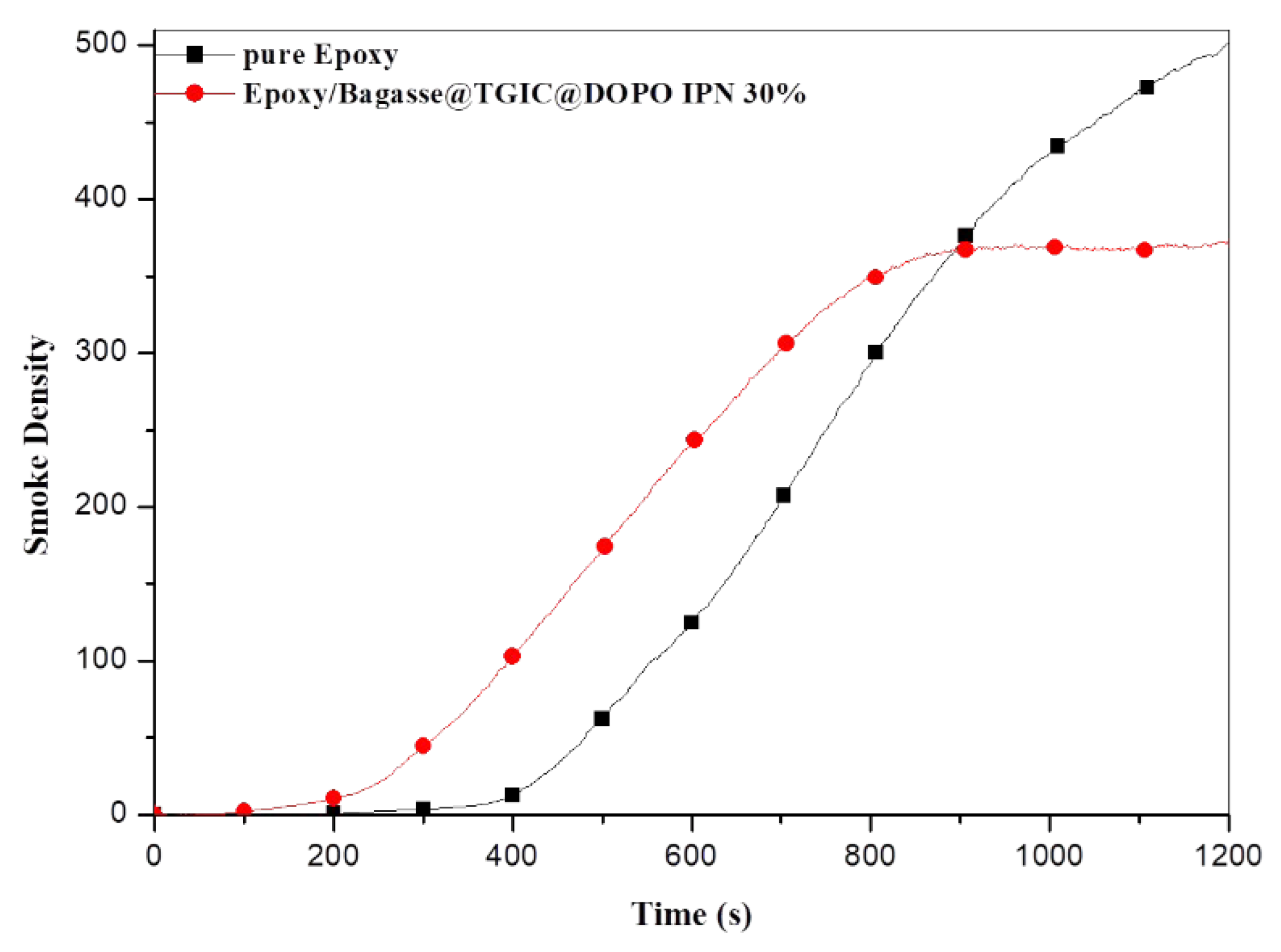

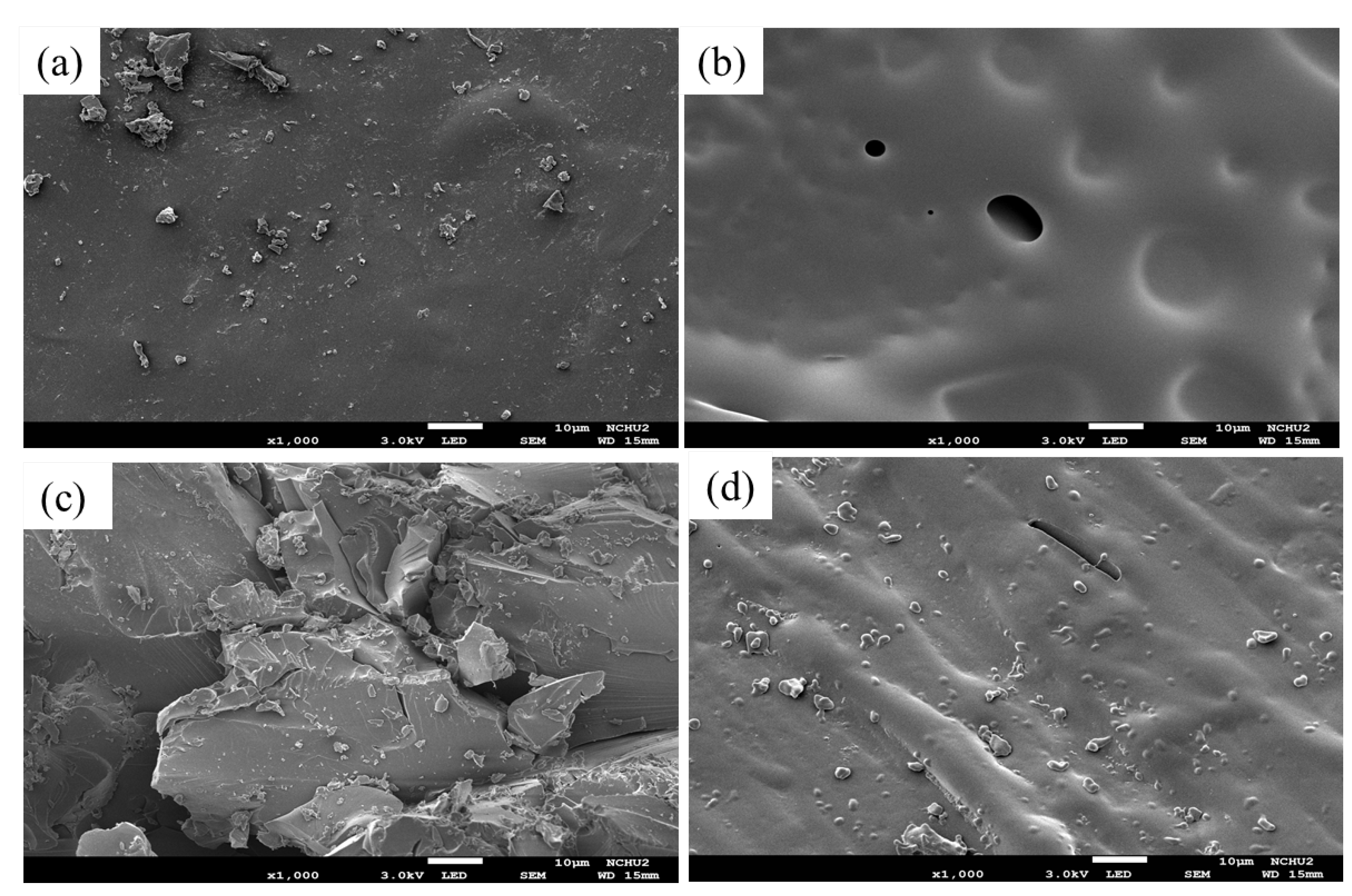


| α | Epoxy/Bagasse@TGIC@DOPO IPN | |
|---|---|---|
| E (kJ/mole) | R Value | |
| 0.1 | 843.3 ± 0.8 | 0.98 |
| 0.2 | 118.2 ± 1.1 | 0.98 |
| 0.3 | 171.2 ± 0.7 | 0.99 |
| 0.4 | 172.3 ± 1.2 | 0.99 |
| 0.5 | 176.3 ± 1.5 | 0.99 |
| 0.6 | 172.2 ± 0.4 | 0.99 |
| 0.7 | 169.3 ± 0.7 | 0.99 |
| 0.8 | 171.3 ± 0.7 | 0.99 |
| 0.9 | 207.1±1.3 | 0.99 |
| △E(av) | 160.3 ± 0.3 | |
| Sample No. | D-Band | G-Band | D/G | |
|---|---|---|---|---|
| 1350 cm−1 | 1580 cm−1 | |||
| Epoxy/Bagasse@TGIC@DOPO IPN 5% | 1 min | 33,063 | 31,415 | 1.05 |
| 5 min | 60,288 | 73,553 | 0.82 | |
| Epoxy/Bagasse@TGIC@DOPO IPN 30% | 1 min | 108,296 | 171,453 | 0.63 |
| 5 min | 65,277 | 172,587 | 0.38 | |
Publisher’s Note: MDPI stays neutral with regard to jurisdictional claims in published maps and institutional affiliations. |
© 2021 by the authors. Licensee MDPI, Basel, Switzerland. This article is an open access article distributed under the terms and conditions of the Creative Commons Attribution (CC BY) license (https://creativecommons.org/licenses/by/4.0/).
Share and Cite
Liu, S.-H.; Ke, C.-Y.; Chiang, C.-L. Thermal Stability, Smoke Density, and Flame Retardance of Ecotype Bio-Based Flame Retardant Agricultural Waste Bagasse/Epoxy Composites. Polymers 2021, 13, 2977. https://doi.org/10.3390/polym13172977
Liu S-H, Ke C-Y, Chiang C-L. Thermal Stability, Smoke Density, and Flame Retardance of Ecotype Bio-Based Flame Retardant Agricultural Waste Bagasse/Epoxy Composites. Polymers. 2021; 13(17):2977. https://doi.org/10.3390/polym13172977
Chicago/Turabian StyleLiu, Shang-Hao, Cing-Yu Ke, and Chin-Lung Chiang. 2021. "Thermal Stability, Smoke Density, and Flame Retardance of Ecotype Bio-Based Flame Retardant Agricultural Waste Bagasse/Epoxy Composites" Polymers 13, no. 17: 2977. https://doi.org/10.3390/polym13172977
APA StyleLiu, S.-H., Ke, C.-Y., & Chiang, C.-L. (2021). Thermal Stability, Smoke Density, and Flame Retardance of Ecotype Bio-Based Flame Retardant Agricultural Waste Bagasse/Epoxy Composites. Polymers, 13(17), 2977. https://doi.org/10.3390/polym13172977






